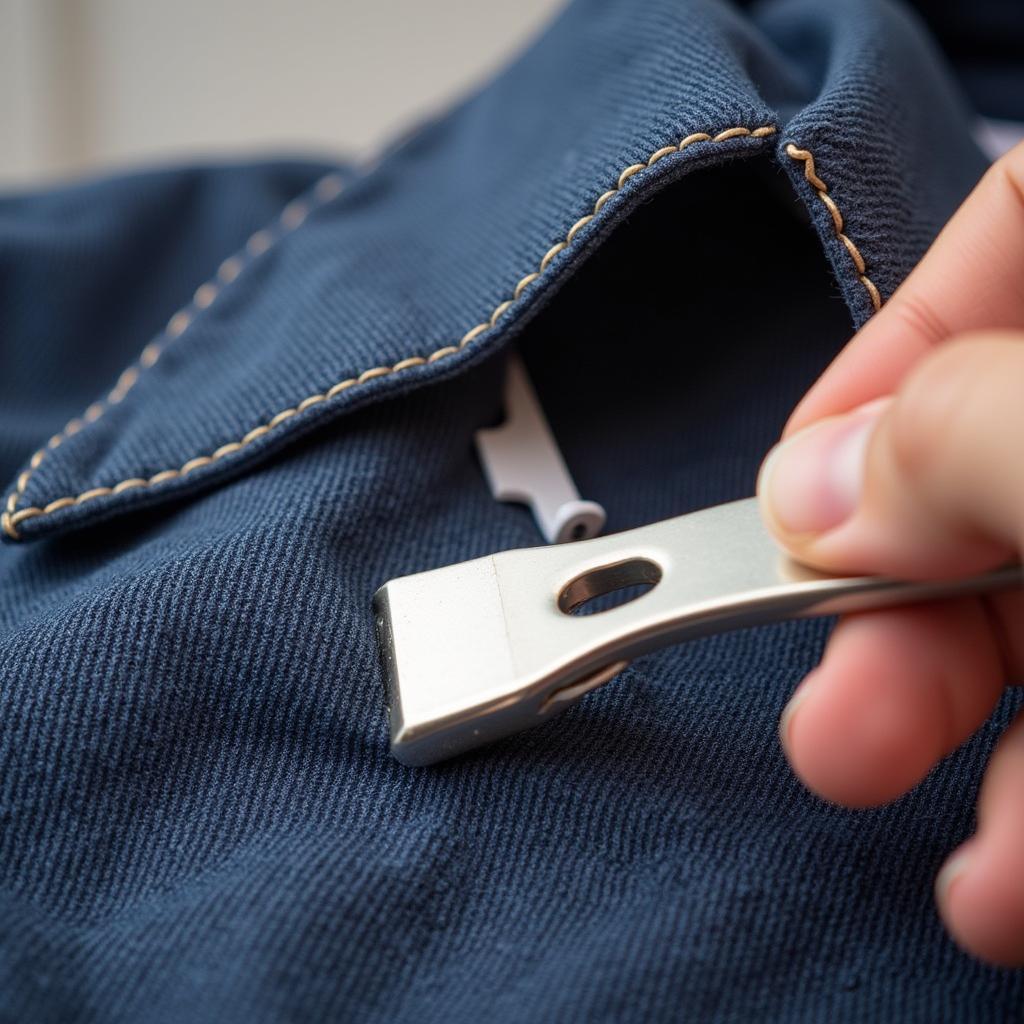Removing anti-theft devices from merchandise can be tricky, and often requires specialized tools. Understanding the different types of devices and how they work is crucial for safe and effective removal. This article will guide you through the process, focusing on the methods used by professionals and offering advice on how to avoid damaging the product.
 Removing an anti-theft device from clothing using a detacher.
Removing an anti-theft device from clothing using a detacher.
Understanding Retail Anti-Theft Devices
Retail stores use a variety of anti-theft devices to protect their merchandise. These range from simple ink tags to more sophisticated electronic article surveillance (EAS) systems. Knowing how these devices work helps in choosing the right removal method. Common types include RF tags, AM tags, and acousto-magnetic (AM) tags. Each utilizes a different technology and requires a specific approach for deactivation or detachment.
How to Remove RF Tags
Radio Frequency (RF) tags are commonly used and are usually deactivated at the checkout using a specialized device. Attempting to remove these without the proper tool can damage the product. How to remove anti theft tag from pants provides more specific information on this type of tag.
“RF tags are designed to be easily deactivated at the point of sale,” says John Smith, a Loss Prevention Specialist with 15 years of experience. “Tampering with them can trigger alarms or damage the merchandise.”
How to Remove AM Tags
Acousto-Magnetic (AM) tags are another popular type. These are often larger and more robust than RF tags. They require a strong magnetic detacher for removal. How to take off anti theft tag target details specific removal techniques for tags commonly used in large retail chains.
Removing Ink Tags
Ink tags are designed to deter theft by releasing ink if tampered with. These require careful handling to avoid staining the merchandise. Attempting to remove these forcefully can result in a messy situation.
Professional Removal Techniques
Retail staff are trained to remove anti-theft devices safely and efficiently. They use specialized tools like detachers and deactivators to ensure no damage is done to the product. Replace battery in mercedes key fob might seem unrelated, but it highlights the importance of using the right tools for specific tasks. Similarly, removing security tags requires specialized equipment.
“The key is using the correct tool for the specific tag,” says Maria Garcia, a retail manager with over 20 years of experience. “Improvised methods can lead to damaged merchandise and frustrated customers.”
What If I Accidentally Took Something Home with a Tag?
If you accidentally left the store with a security tag still attached, the best course of action is to return to the store with the item and receipt. The staff can then remove the tag using the appropriate tools. How to get off anti-theft devices with a magnet discusses using magnets, but attempting this without proper knowledge can be risky.
Why Shouldn’t I Try to Remove Tags Myself?
Attempting to remove retail anti-theft devices yourself can lead to several issues:
- Damage to the product: Improper removal techniques can tear fabric, scratch surfaces, or break delicate items.
- Ink stains: Tampering with ink tags can release ink and permanently stain the merchandise.
- Triggering alarms: Some tags are designed to trigger alarms even after leaving the store.
- Legal trouble: Attempting to circumvent anti-theft measures could be misinterpreted as shoplifting.
How to remove anti theft security tag provides further details on why professional removal is the safest option.
Conclusion
Removing retail stores anti-theft devices requires the proper tools and knowledge. Attempting to remove them yourself can damage the product and potentially lead to other complications. Returning to the store or contacting customer service is the safest and most effective way to have anti-theft devices removed. Remember, professional removal ensures the product remains undamaged and avoids any potential legal misunderstandings.


